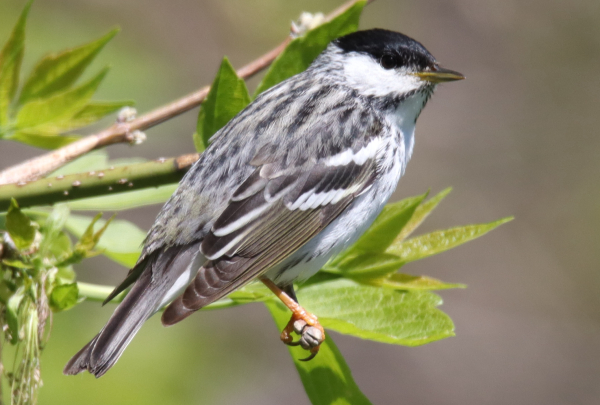
Last week turned out to be the songbird week that I savor each year, with mini-fallouts each day accented by a full-scale fallout Friday. Each morning provided photo opportunities with migrating songbirds – warblers, vireos, orioles, thrushes, and more; plus Friday evening provided a second chance to photograph some surprise warblers. Once the action starts in this area about mid-May, it gets better and better until all the migrants have passed by the last day of the month (with a few slow days mixed in along the way). It’s exciting and I make the most of it – everything else in my life revolves around the warbler action, and I’ve already had excellent photo successes this May with more on the way, I’m sure.
I’ve been following every point I made 3 weeks ago in the May 3rd issue, where we provided a primer for photographing migrating songbirds in that week’s Bird Photography feature. Each spring, I’m always on the lookout for a flock of warblers as I travel the area, and the region; but having spent about a dozen springs here over the past 20-plus years, I’ve found 3 primary fallout hotspots, with the best of the trio, Melody’s Grove, just 200 yards from home. That close proximity permits me to check on the potential action each morning, and each morning is different. I never know what to expect, but the dividends can be great when an overnight migration is short-stopped by rain or wind, or both; although any late May morning a few warblers can provide adrenaline charges and fine photos.
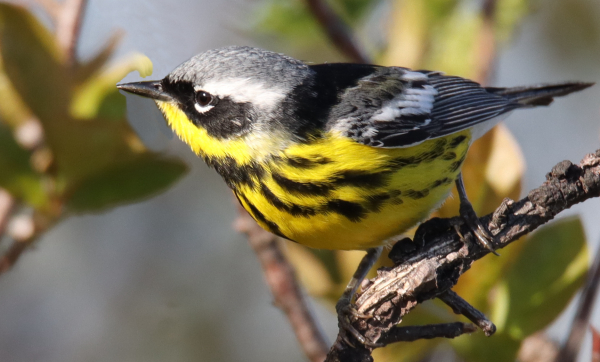
How about you? Have you found a location or 2 where you can find a few colorful songbirds to photograph? Every May migration is different, but one thing that can be fruitful is to check on flowering trees – apple trees, cherry trees, chokecherries, wild plum trees, and more can be a magnet for small insects, and therefore for small birds. Each of my hotspots is a small islands of trees in a vast area of prairie grasslands mixed with agricultural fields. During migration, tired and hungry songbirds key in on these islands of trees, which provide valuable areas of habitat.
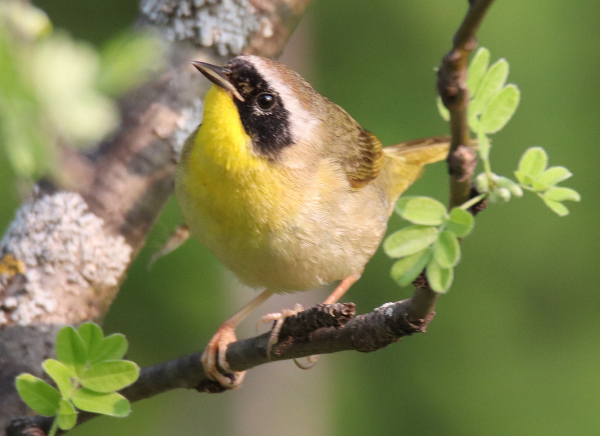
Common threads between most warblers are that warblers are small, they move quickly, and they often favor shaded areas over perches bathed in sunlight, which made photographing this Common Yellowthroat rewarding (600mm zoom, f-6 aperture, 1/400 shutter speed, ISO 800).
|
When birds are present, I tend to spend a couple hours on site at a time, but stay as long as the birds dictate. Usually midday is slow, and that’s when the lighting is much less usable, so even on good days I tend to make 2 primary visits to photograph, along the east side during morning and along the west side during late afternoon, when the sun is shining. If the morning lacks birds at Melody’s Grove, there is little chance there will be bird activity during the afternoon, but I check it for a few minutes each afternoon anyway, just in case. The Lake hotspot tends to be a better afternoon photo site, especially when the wild plums or chokecherries are in bloom. Sometimes, a single bird can provide an exceptional photo opportunity, as evidenced in last week’s Bird Photography feature in which I shared photos of a single Mourning Warbler and the story behind that photography episode.
Actually, I can point to a single bird or two as being a standout each day – partly by their being a new arrival, partly by providing a few photographs. Wednesday it was another Mourning Warbler plus a chance Black-and-White Warbler; Thursday a Red-eyed Vireo, and Friday a Magnolia Warbler and a Wilson’s Warbler; Saturday it was an American Redstart and a Blackpoll Warbler, and Sunday it was the Common Yellowthroat – very fun indeed.
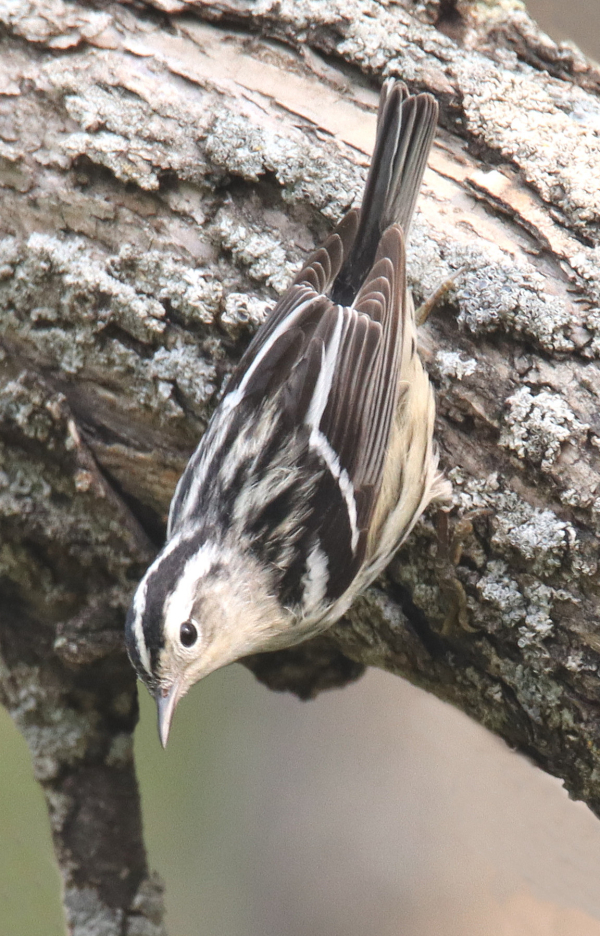
This image is misleading in that Black-and-White Warblers rarely ever stop moving as they forage along tree trunks and branches, which make trying to photograph them challenging (photo info: 600mm zoom, f-6 aperture, 1/640 shutter speed, ISO 800).
|
Part of the excitement and part of the enjoyment of warbler photography is following the fast action these small songbirds create as they move quickly while also slipping in and out of view as they meander through vegetation to search for small insects and spiders. As you follow their progress through your camera lens, it’s important to try to anticipate their next move while paying attention to the shadows, as well as the surrounding plants and other background elements.
One thing I’ve found I have improved on this year is keeping aware of shadows on the birds I’m photographing as they move through vegetation, plus the shadows created by the birds’ angle to the sunlight, which can create a darker shadow on one side of the bird, or below a bird’s chest, or even under its beak. I watch for and can see shadows much better now after being more aware of them, and I wait for a bird to be in the clear before I take photos. By limiting your photography sessions to morning and late afternoon hours, shadows will be less of a concern with the sun behind you as you photograph.
In a similar way, I’ve tried to be more aware of background elements including branches, leaves, flowers, and grass. And I continue to work on trying not to tense up when I’m excited and in the moment photographing active warblers. Relax, enjoy the moment, stay loose. But hold your breath when you take each photo, steady yourself as best you can, and be aware of other birds and activities around you. During each photo session, as I await the next birds to pass by I always seem to get a wisp of super-fresh air, which reminds me to enjoy all the outdoors has to offer.
For most warbler photography in my area, I use my vehicle as a comfortable mobile blind because birds react to the sight of people, and certainly to a moving person, but they mostly ignore a parked vehicle. At Melody’s Grove I can pass along the edge of the trees and bushes, where songbirds are bathed in sunlight as they feed at or near the edge of vegetation and move into the adjacent grasses. Mornings I operate on the east side of the grove when the rising sun is in the eastern sky; and during late afternoon I photograph along the southwest side with the low sun to the west.
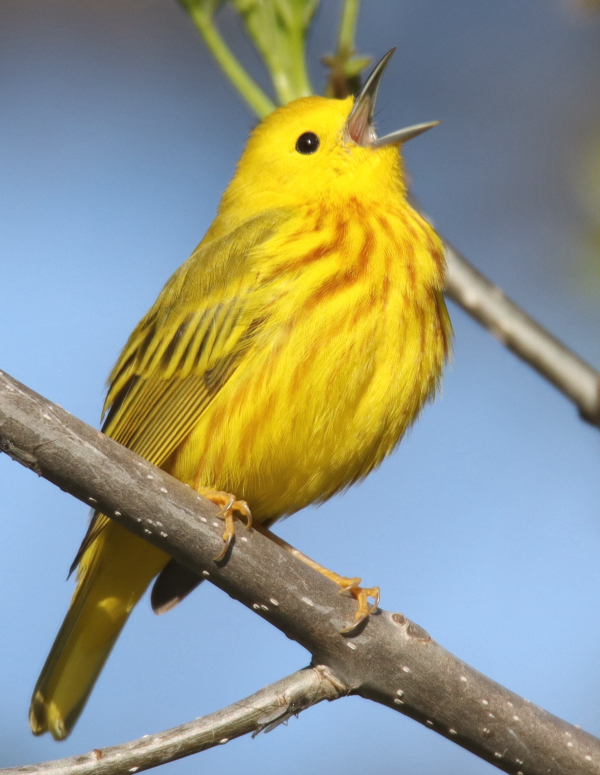
Aside from the green crown and branch above and behind this singing Yellow Warbler, this image would be tough to beat, showing accurate color, sharpness, and action. The bottom line is that getting quality warbler photographs is difficult, but oh so enjoyable (600mm zoom, f-6 aperture, 1/1600 shutter speed, ISO 400).
|
A great option to using a mobile blind is that you can reposition any time you wish, driving 20 yards forward or a few yards backward as bird activity or other variables may suggest. I have a few favored places to park, sometimes next to a flowering tree or bush, sometimes where there is a lush area of vegetation where songbirds are foraging, and other times where open perches favor taking photographs.
There has been a bit of a lull in the songbird photo action the past couple days, but I’m anticipating another surge in warbler arrivals this week, so don’t be surprised if there is a “Warbler Week II” feature in the next issue of The Birding Wire. The third wave of warblers and other songbirds tends to be the most interesting, and considering how well the migration has progressed to date, I’m expecting more fine photo ops between now and the end of the month.
Whether you are on foot or stationary, try to position yourself in the right places to intercept birds during prime morning sunlight or late afternoon sunlight periods, and with a lot of luck and patience you will have rewarding successes photographing colorful warblers and other small songbirds you encounter. Make the most of the coming Memorial Day holiday weekend by getting some bird photography time in, and Good Luck!
Article and photographs by Paul Konrad
Share your bird photos and birding experiences at editorstbw2@gmail.com
